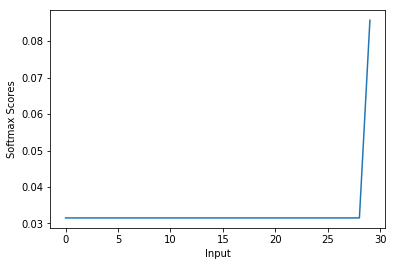Softmax
The property of softmax function
(a) prove that softmax is invariant to constant offsets in the input,that is, for any input vecotr x and any constant c,
$$softmax(x + c) = softmax(x)$$
which x+c means adding the constant c to every dimension of x.
First all of,to prove the softmax function:
$$softmax(x_i + c) = \frac {e^{x_i + c}}{\sum_j e^{x_i + c}} $$
$$ = \frac {e^x_i \cdot e^c}{\sum_j e^{x_i} \cdot e^c} $$
$$ = \frac {e^x_i}{\sum_j e^{x_i}} $$
$$ = softmax(x_i) $$
Implementation in python.
(b)Write my implementation in q1_softmax.py and test it.
From the mathematical point of view,let’s try my solution(Jacksoftmax):
|
|
Let’s take basic test example:
|
|
This is the out:
[ 0.26894142 0.73105858]
[[ 0.26894142 0.73105858]
[ 0.26894142 0.73105858]]
[[ 0.73105858 0.26894142]]
Use this space to test your softmax implementation by running:
python q1_softmax.py
|
|
Running your tests...
Enter the dimension of the matrix:
3
5
The first sample is:
[[ 0.0345306 0.18920816 0.49485403 0.03642509 0.90002219]
[ 0.9100086 0.61635177 0.8217402 0.69910275 0.59564619]
[ 0.01915225 0.8879781 0.35720632 0.57615048 0.09329815]]
The answer with softmax of sklearn:
[[ 0.14025367 0.16371552 0.22224406 0.14051963 0.33326711]
[ 0.23802995 0.17745901 0.21792002 0.19276863 0.1738224 ]
[ 0.13142823 0.31333935 0.18429081 0.22939815 0.14154346]]
The answer with my softmax:
[[ 0.14025367 0.16371552 0.22224406 0.14051963 0.33326711]
[ 0.23802995 0.17745901 0.21792002 0.19276863 0.1738224 ]
[ 0.13142823 0.31333935 0.18429081 0.22939815 0.14154346]]
The second sample is:
[[ 4.43086839 4.35889742 -1.00466532 0.65716001 6.19049139]
[ 5.66895751 3.98764183 5.77718425 -0.33103714 -0.18460528]
[-1.35308692 1.1158278 -0.9865306 3.25704449 0.23047689]]
The answer with softmax of sklearn:
[[ 1.28731109e-01 1.19791752e-01 5.61127060e-04 2.95653336e-03
7.47959479e-01]
[ 4.33693148e-01 8.07228412e-02 4.83264437e-01 1.07502359e-03
1.24455056e-03]
[ 8.35966458e-03 9.87244880e-02 1.20609700e-02 8.40124177e-01
4.07307003e-02]]
The answer with my softmax:
[[ 1.28731109e-01 1.19791752e-01 5.61127060e-04 2.95653336e-03
7.47959479e-01]
[ 4.33693148e-01 8.07228412e-02 4.83264437e-01 1.07502359e-03
1.24455056e-03]
[ 8.35966458e-03 9.87244880e-02 1.20609700e-02 8.40124177e-01
4.07307003e-02]]
Follow the result i will get the correct answer by doing vectorization.
How to use it?
Now,We use the implemented softmax function to create the graph to understand the behavior of this function:
- To create a list which contains values in the range of 0 to 10
- Next,pass the list to calculate the scores from the softmax function
- To create a graph.
|
|
[ 0 1 2 3 4 5 6 7 8 9 10 11 12 13 14 15 16 17 18 19 20 21 22 23 24
25 26 27 28 29]
[ 0.03152756 0.03152756 0.03152756 0.03152756 0.03152756 0.03152756
0.03152756 0.03152756 0.03152756 0.03152756 0.03152756 0.03152756
0.03152756 0.03152756 0.03152756 0.03152756 0.03152756 0.03152756
0.03152756 0.03152756 0.03152756 0.03152756 0.03152756 0.03152756
0.03152756 0.03152756 0.03152756 0.03152756 0.03152756 0.08570079]

The figure shows the property of softmax function:
The high value gets the hign score(means probability).
We can use the softmax function to multi-classification task.